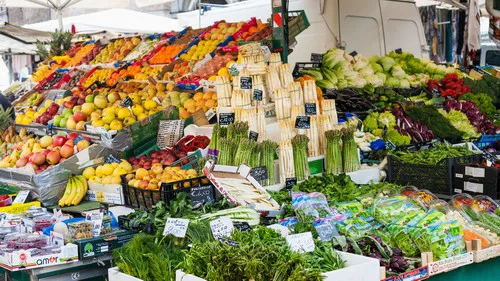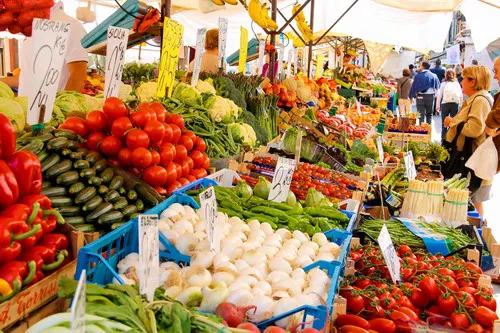The trend in the domestic consumption of fresh fruit and vegetables was still negative in the first quarter of this year, with purchases by Italian households standing still at 1.27 million tons, equivalent to a decrease over the same period in 2022 of 8%. January, February and March all presented negative scores. January originally started the year with a steep 10% decrease, followed by February -5% and March -8%. This makes it 17 consecutive months - starting in November 2021 - that have shown negative changes in comparison to the same period of the previous year.
This is what emerges from the statistics processed by CSO Italy's Market Observatory on the basis of surveys conducted by GfK Italy. There are several underlying reasons for this worrisome situation, but the economic difficulties of families, accentuated by the inflationary push, as well as the problems of production, squeezed by extreme weather events, have certainly played their part.
The average purchase price in the case of fruit and vegetables on a three-month basis marks +8% in 2023 compared to the first quarter of 2022, while if we extend the comparison to five years, the differential increases to +21%.
"Unfortunately, the trend is still negative, and it will be difficult to reverse this trend in the short term, unless a fresh brand-new communication strategy integrates the many different habits that influence consumer decisions. There is inflation and we need to take that into account, but there is also a desire for innovation, for more sustainability, for greater attention to one's physical well-being, with a focus on the trends among the young population," added Elisa Macchi, director of CSO Italy and head of the Observatory.
Each Italian (regardless of age) consumed in these first three months of the year 4kg less than in 2019 and almost 2kg less than in 2022.
 Photo © Vvoevale | Dreamstime.com
Photo © Vvoevale | Dreamstime.com
The total volume of fruit purchased during the quarter was 644 thousand tons, a significantly lower quantity on the year 2022 (-10%), which had also marked a sharp decline. For the first time, the fruit sector fell below 700 thousand tons for the period under review. There was also a negative record for fruit spending, which fell by 2 percent with a total of €1.32 billion, despite an increase in the average purchase price from €1.90/kg in the first quarter of 2022 to €2.06/kg.
The volume of vegetables purchased in the first quarter of 2023 is close to the quantities recorded for the fruit sector. At 635 thousand tons, vegetables decreased -6% compared to the equivalent in 2022 and a -13% over a span of five years. The total amount spent on vegetables in the period is about 1.5 billion euros, while the average prices mark an increase reaching €2.06/kg, which is 8 percent higher than the first quarter of 2022.
Coming down in detail by single variety, we find a scenario dotted with mostly negative circumstances. Among the top ten fruit species purchased by volume in these first three months of the year, only pears and kiwis have shown positive signs. At just over 27,000 tons, pears mark a +29%, however, one must keep in mind of a very negative 2022 with volumes that are still far below the average for the period, even excluding last year.
Kiwis recorded a 5% increase, amounting to a volume of 24 thousand tons. Oranges dropped -10% and to 196 thousand tons, clementines plummeted to a meager -22% and lemons experienced a -16% drop. The second most purchased fruit in the first quarter, namely apples, decreased by -8% and bananas, closely behind oranges and apples, by dropped by -9%. The strawberry campaign has not started well either, marking a -9% drop in purchases.
All dried fruit is down, even by double digits.
The situation for vegetables is complex but not all bad. There are three species in the top 10 here that have increased in the first quarter compared to the previous year; this is the case for tomatoes (+4%), fennel (+31%) and courgettes (+7%). The setback suffered by potatoes (-3%) affected the entirety of the total as they are also the most voluminous species. Carrots dropped by 9%. Strong decreases occurred also for salads (-14%) and artichokes (-27%). But even beyond the ten most consumed species, it is the negative signs of variation that have been dominating the scene, often with double-digit shortfalls.
 Photo © Nicknickko | Dreamstime.com
Photo © Nicknickko | Dreamstime.com
The fresh-.cut sector was impacted by the overall situation with a halt to its growth experienced in the historical series from 2019 to date. Salads are back to the 2021 levels with almost 24,000 tons for the first quarter of 2023 but are down 4 percent compared to 2022; processed mixed vegetables are up 2 percent while other vegetables lost 20 percentage points. The decline in the purchase of fresh fruits and vegetables appears to be widespread across all trade channels, albeit unevenly.
"The first, and most important, observation regarding volumes, is inherent to discount stores, which with 252,000 tons not only consolidate their position in second place as preferred channel of for the purchase of fruit and vegetables but are also the source of supply that remains most stable in the first quarter compared to 2022 with a limited -1%. On the historical side, discount stores also kept a steady trend for the first period of the year, which is a white fly in the big picture," says Daria Lodi of CSO Italy.
With 45% of volumes in the first quarter of 2023, the supermarkets in Italy, which represent the primary consumer source, handled just under 590 thousand tons, -5% when compared to the same period last year, while maintaining a high and stable penetration index at 83%.
As part of the large-scale retail sector, we next have hypermarkets in constant and continuous contraction, falling below 124 thousand tons (-8%) and superettes or small areas with 25 thousand tons (-12%).
Specialized outlets or greengrocers, as well as hawkers do not show any signs of slowing down the sharp decline.
The drop in purchases has affected all areas of the country, ranging from -12% in Northeast Italy to -3% in the South and Sicily.
For the third year in a row, the share of packaged fruit and vegetables has grown from 34 percent of purchases in 2019 to 41 percent in the first quarter of 2023, indicating a certain stability of volumes in a context of downtrending purchases.
Finally, it should be noted that the purchase of organic fruit and vegetables in the first quarter of 2023 was not positive either, accounting for -7 percent compared to 2022. If compared with five years ago, the decline rises to 16%. However, the CSO Italy statisticians observed that households that for several years have approached the organic product, thus allowing a significant expansion of it, are not decreasing; what is going down is the volume acquired per purchasing family, confirming that it is the general inflation that is taking a bite out of consumption.
